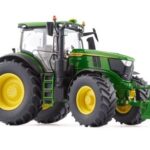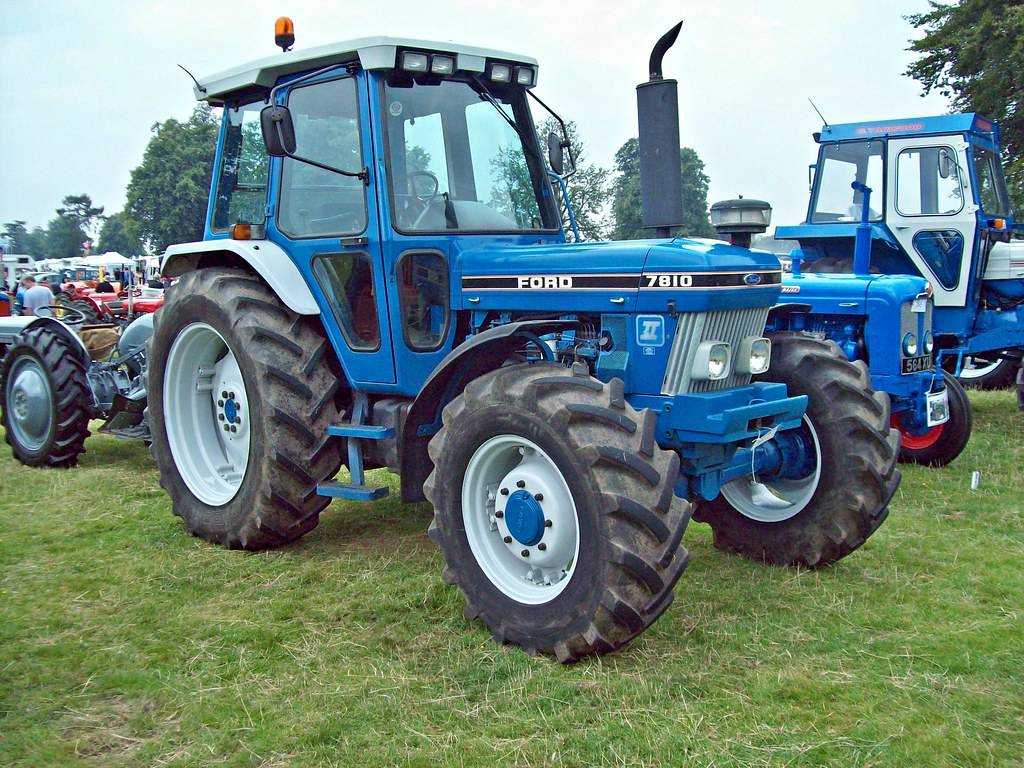An in-depth analysis of the Evolution of Front-Wheel Drive Tractors

Tractors with front-wheel drive (FWD) are changing agriculture. Originally a unique idea, this is now standard practice in contemporary farming. This article traces the development of the Evolution of Front-Wheel Drive in Tractors from the first inventions to the most sophisticated systems available today. We’ll examine the advantages, significant events, and upcoming developments to give you a thorough understanding of how FWD has changed the farming environment.
The Early Days of Tractor Development
Birth of the Tractor
Tractors were first conceptualized in the late 1800s. Early tractors were primarily powered by steam, but they later switched to petrol engines. These devices were large and heavy, with a power-maximizing design. Front-wheel drive was not yet considered due to the primary challenges of achieving sufficient traction and power delivery.
The First Innovations
Tractors became more effective and economical at the start of the twentieth century. Companies started experimenting with different types of drives. It was the standard since rear-wheel drive (RWD) offered the traction required to tow large objects. But as farming requirements changed, so did the need for drive systems that were more adaptable and effective.
Introduction of Front-Wheel Drive in Tractors
The Need for Better Traction
With the increasing importance of tractors in farming, the drawbacks of rear-wheel drive became clear. Improved traction was necessary for farmers, particularly in difficult situations like soggy fields or steep terrain. As a potential remedy, the front-wheel drive was investigated.
Early Attempts at Front-Wheel Drive
The initial tractor trials utilizing front-wheel drive yielded inconsistent outcomes. Achieving a balanced power distribution among the front and rear wheels presented issues for the engineers. Their frequent complexity and expense constrained the use of early FWD systems. But these early efforts set the stage for later breakthroughs.
The Breakthrough
The middle of the twentieth century saw the invention of front-wheel drive. Developments in engineering and materials allow for the creation of more dependable and effective FWD systems. Front-wheel drive tractors started to provide better traction and maneuverability, particularly in challenging circumstances. This made them especially helpful for jobs requiring steadiness and accuracy.
The Impact of Front-Wheel Drive on Farming
Enhanced Traction and Stability
Increased traction is one of the main advantages of front-wheel drive-in tractors. The four wheels of FWD tractors can distribute power more equally, reducing the likelihood of slippage. This is crucial since conventional rear-wheel drive tractors may have trouble in muddy or damp weather.
Improved Maneuverability
Additionally, front-wheel drive enhances maneuverability. Tractors with front-wheel drive (FWD) have improved turning and tight-spacing capabilities. This is a big benefit when working in narrow fields or around barriers. Making tighter bends also requires less time and effort to complete chores like tilling and plowing.
Increased Efficiency
With better traction and maneuverability, front-wheel drive tractors offer increased efficiency. Farmers can complete tasks more quickly and with greater precision. This leads to higher productivity and reduced fuel consumption, making FWD tractors a cost-effective choice.
Key Milestones in the Evolution of Front-Wheel Drive Tractors

The Introduction of All-Wheel Drive:
Four-wheel-drive (AWD) systems were a logical advancement from the front-wheel drive. Because AWD tractors power all four wheels at once, they provide considerably more traction and stability. Huge-scale agricultural operations, where tractors must manage huge loads and difficult terrain, have benefited greatly from this technique.
The Shift to Advanced Electronics:
Front-wheel engines transformed the latter part of the twentieth and early twenty-first centuries due to the integration of modern electronics. Modern FWD tractors optimize power distribution in real-time, thanks to their computer controls and sensor systems. This guarantees optimal effectiveness and output, even under the most taxing circumstances.
The Rise of Compact Tractors:
The growing number of compact tractors has fueled the acceptance of front-wheel-drive vehicles in recent years. In vineyards and orchards, where maneuverability is essential in specialized farming activities, we frequently use smaller tractors. Compact tractors with front-wheel drive are an indispensable tool for small-scale cultivators since they can maneuver through narrow locations and carry out precise operations.
The Role of FWD in Precision Agriculture:
Farmers use modern technology to maximize farming techniques in precision agriculture. This is where front-wheel drive comes in handy because it makes operating tractors more precise. FWD tractors with GPS guidance can follow exact routes, reducing overlap and guaranteeing uniform coverage. Precision agriculture becomes more profitable and sustainable as a result of maximizing yields and decreasing waste.
Challenges and Innovations in Front-Wheel Drive Technology
Balancing Power Distribution:
Power distribution among both the front and back tires is one of the primary problems with front-wheel drive systems. Inadequate power distribution might result in inefficiencies and more component wear on the tractor. Modern FWD systems’ advanced electronics monitor and adjust power distribution in real time to guarantee peak performance.
Durability and Maintenance:
Front-wheel drive tractors usually have more wear and tear than their rear-wheel drive counterparts. Several additional components needed to operate Four Wheel Drive (FWD) setups are the transmission shafts and differentials. Improper maintenance can lead to these parts breaking easily. However, advancements in materials science and engineering have strengthened FWD tractors’ durability, reducing maintenance costs and lengthening their lifespan.
The Integration of Automation:
One notable improvement in front-wheel-drive tractors is the inclusion of automated procedures. With the use of sensors and GPS navigation systems, autonomous front-wheel drive tractors can carry out duties without the need for human interaction. Efficiency is increased and less manual labor is required as a result. Although it is still in its infancy, more autonomous tractors are anticipated to be used in the upcoming years.
The Role of FWD in Sustainable Farming:
A major issue regarding farming is sustainability, and front-wheel drive tractors may assist in implementing more environmentally friendly agricultural methods. FWD tractors contribute to a reduction in the carbon footprint of farming operations by increasing efficiency and consuming less fuel. Furthermore, soil compaction is reduced by the accuracy provided by FWD systems, which is crucial for preserving healthy soil and increasing crop yields.
The Future of Front-Wheel Drive in Tractors
- Continued Technological Advancements: Tractors with front-wheel drive will probably see changes in the future due to ongoing technology improvements. Further advancements in sensors, electronics, and materials science will make FWD systems increasingly more dependable and efficient. More automation and artificial intelligence integration should be seen, expanding the potential of FWD tractors.
- The Role of FWD in the Global Farming Market: Front-wheel drive tractors will play a critical role in addressing the growing worldwide demand for food. Increasing production and efficiency will be greatly aided by FWD tractors, particularly in areas with difficult farming circumstances. FWD technology’s ongoing development will support farmers worldwide in producing food in a way that is both economical and sustainable.
- Potential Challenges and Solutions: Front-wheel drive tractors appear to have a bright future, but there may be certain issues that need to be resolved. The expense of FWD systems, which can be expensive for farms with small acres, is one of the primary obstacles. But as production prices come down and technology advances, we should expect to see more reasonably priced FWD options available. The complicated nature of maintaining FWD tractors is another difficulty. These systems may require more specialized upkeep and repairs as they become more sophisticated. Ongoing advancements in robustness and dependability, along with the accessibility of guidance and assistance, will aid in lessening these difficulties.
Conclusion (Final Words)
The development of tractor front-wheel drive had a significant effect on farming. From its inception as an original idea to its current status as a regular component of newer tractors, front-wheel drive (FWD) has revolutionized the farming industry. Front-wheel drive has improved traction, strength, and efficiency, which has increased farming’s productivity and sustainability.
Looking ahead, front-wheel drive technology development will be essential to satisfying the world’s increasing food demand and maintaining the sustainability of agricultural methods worldwide. Front-wheel drive (FWD) in tractors has an exciting future, whether it is using the integration of automation, the development of more robust and efficient systems, or the introduction of FWD to new markets.










